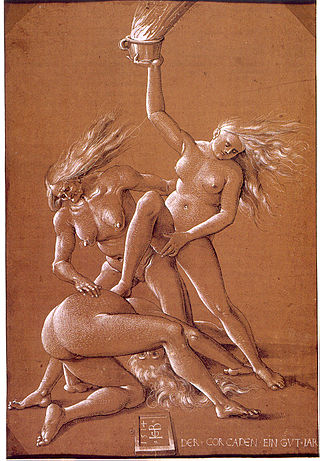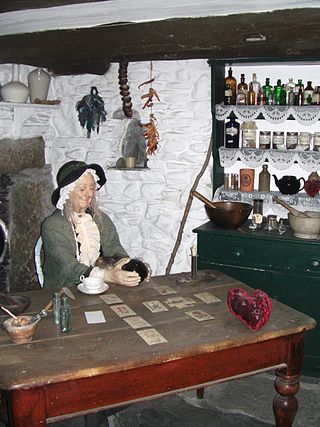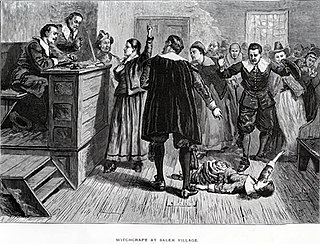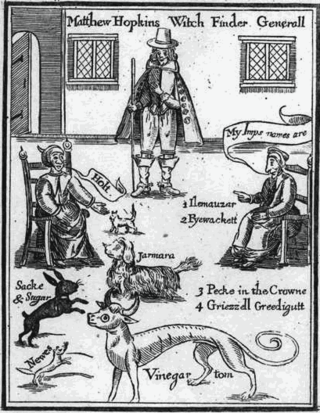
Ledston is a village in the Leeds metropolitan borough, in the county of West Yorkshire, England. It is 3 miles (5 km) north of Castleford and 10 miles (16 km) east of Leeds. The parish had a population of 400 in 2001, which decreased slightly to 394 at the 2011 Census.

In European folklore of the medieval and early modern periods, familiars were believed to be supernatural entities or spiritual guardians that would protect or assist witches and cunning folk in their practice of magic. According to records of the time, those alleging to have had contact with familiar spirits reported that they could manifest as numerous forms, usually as an animal, but sometimes as a human or humanoid figure, and were described as "clearly defined, three-dimensional... forms, vivid with colour and animated with movement and sound", as opposed to descriptions of ghosts with their "smoky, undefined form[s]".
Mary Ann Warren was an accuser and later confessed witch during the 1692 Salem witch trials. She was a servant for John and Elizabeth Proctor. Renouncing her claims after threats of beating from her master, she was later accused and arrested for allegedly practicing witchcraft herself, after which she again became afflicted and accused others of witchcraft. Her life after the trials is unknown.

European witchcraft is a multifaceted historical and cultural phenomenon that unfolded over centuries, leaving a mark on the continent's social, religious, and legal landscapes. The roots of European witchcraft trace back to classical antiquity when concepts of magic and religion were closely related, and society closely integrated magic and supernatural beliefs. Ancient Rome, then a pagan society, had laws against harmful magic. In the Middle Ages, accusations of heresy and devil worship grew more prevalent. By the early modern period, major witch hunts began to take place, partly fueled by religious tensions, societal anxieties, and economic upheaval. Witches were often viewed as dangerous sorceresses or sorcerers in a pact with the Devil, capable of causing harm through black magic. A feminist interpretation of the witch trials is that misogynist views of women led to the association of women and malevolent witchcraft.

The Witches of Belvoir were a mother and her two daughters accused of witchcraft in England and the deaths of two young brothers, Henry and Francis Manners, the heirs to Francis Manners, 6th Earl of Rutland, whose seat was at Belvoir Castle. The mother, Joan Flower, died on the way to her trial after apprehension 'around Christmas' of 1618, while Philippa and Margaret were executed by hanging on 11 March 1619.
Elizabeth Howe was one of the accused in the Salem witch trials. She was found guilty and executed on July 19, 1692.

The trials of the Pendle witches in 1612 are among the most famous witch trials in English history, and some of the best recorded of the 17th century. The twelve accused lived in the area surrounding Pendle Hill in Lancashire, and were charged with the murders of ten people by the use of witchcraft. All but two were tried at Lancaster Assizes on 18–19 August 1612, along with the Samlesbury witches and others, in a series of trials that have become known as the Lancashire witch trials. One was tried at York Assizes on 27 July 1612, and another died in prison. Of the eleven who went to trial – nine women and two men – ten were found guilty and executed by hanging; one was found not guilty.

Cunning folk, also known as folk healers or wise folk, were practitioners of folk medicine, helpful folk magic and divination in Europe from the Middle Ages until the 20th century. Their practices were known as the cunning craft. Their services also included thwarting witchcraft. Although some cunning folk were denounced as witches themselves, they made up a minority of those accused, and the common people generally made a distinction between the two. The name 'cunning folk' originally referred to folk-healers and magic-workers in Britain, but the name is now applied as an umbrella term for similar people in other parts of Europe.
Grace White Sherwood (1660–1740), called the Witch of Pungo, is the last person known to have been convicted of witchcraft in Virginia.
James Murrell, also known as Cunning Murrell, was an English cunning man, or professional folk magician, who spent most of his life in the town of Hadleigh in the eastern English county of Essex. In this capacity, he reportedly employed magical means to aid in healing both humans and animals, exorcising malevolent spirits, countering witches, and restoring lost or stolen property to its owner.

Martha Carrier was a Puritan accused and convicted of being a witch during the 1692 Salem witch trials.

The Castleford–Garforth line was a single-track railway line in West Yorkshire, England, connecting Castleford with Garforth east of Leeds. The route was developed to allow coal to be transported from the area, though a passenger service was operated between 1878 and 1951. Initially promoted by Leeds, Castleford and Pontefract Junction Railway, it was taken over by the North Eastern Railway before the line was completed.
Witch-hunts are still occurring in Nepal in the twenty-first century, and the persecution of marginalised individuals of the community, especially women, still persists. Witchcraft is believed to be the exercise of supernatural powers by witches. Although Nepal does not have a recorded history of systematic witch-hunts, belief in the supernatural, magic, and humans capable of exploiting both to do good or harm is pervasive. In many instances, witch-hunts are simply tribal scapegoating measures carried out to serve ulterior motives, such as getting revenge or winning property disputes.

Lilias Adie was a Scottish woman who lived in the coastal village of Torryburn, Fife, Scotland. She was accused of practising witchcraft and fornicating with the devil but died in prison before sentence could be passed. Her intertidal grave is the only known one in Scotland of an accused witch – most were burned.
The witch trials in the Netherlands were among the smallest in Europe. The Netherlands are known for having discontinued their witchcraft executions earlier than any other European country. The provinces began to phase out capital punishment for witchcraft beginning in 1593. The last trial in the Northern Netherlands took place in 1610.

In England, witch trials were conducted from the 15th century until the 18th century. They are estimated to have resulted in the death of perhaps 500 people, 90 percent of whom were women. The witch hunt was at its most intense stage during the English Civil War (1642–1651) and the Puritan era of the mid-17th century.
Catharine Wolpmann was a German mayor's wife. She was famously charged with witchcraft in Verden in 1647, which resulted in an intervention by Queen Christina of Sweden banning witch trials in the Swedish province in Germany.

The Maryland Witch Trials were a series of hearings and prosecutions of people accused of witchcraft in Colonial Maryland between June 1654, and October 1712. It was not unique, but is a Colonial American example of the much broader phenomenon of witch trials in the early modern period, which took place also in Europe.

During a 104-year period from 1626 to 1730, there are documented Virginia Witch Trials, hearings and prosecutions of people accused of witchcraft in Colonial Virginia. More than two dozen people are documented having been accused, including two men. Virginia was the first colony to have a formal accusation of witchcraft in 1626, and the first formal witch trial in 1641.

The Witch Child of Pilot's Knob is a Kentucky urban legend that tells of a five-year-old girl named Mary Evelyn Ford and her mother, Mary Louise Ford, being burned at the stake in the 1900s for practicing witchcraft in the town of Marion, Kentucky.













